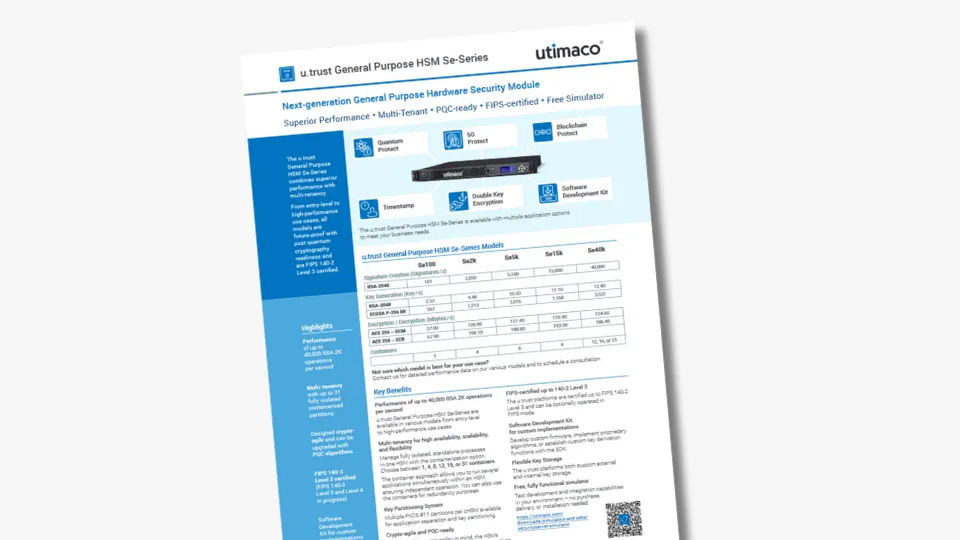Imagine standing before a breathtaking painting—a masterpiece unmistakably marked by the artist's signature in the corner. That signature is not just an adornment; it is a declaration of authenticity, proving that the work is genuine and not a forgery.
Just as an artist’s signature guarantees their work, code signing assures that a piece of software comes from a trusted source and has not been tampered with. This process does not only ensure authenticity but also protects systems from malicious intrusions. Yet, while a forged painting might only deceive a collector, installing counterfeit code can have severe consequences—compromising entire systems, creating gateways for hackers, or containing ransomware.
This article introduces the concept of code signing and highlights how Hardware Security Modules (HSMs) can elevate the security of code signing practices.
Test HSM functionalities for code signing with our free simulator
What is Code Signing?
As described earlier, code signing is basically the process of signing a software file with a digital signature.
The purpose of the digital signature is to identify the issuer of the code and the recipient to validate its authenticity and check if it comes from a trusted – and expected – source.
You will find more information about code signing here >>
Why is Code Signing Needed?
Code signing ensures the authenticity and integrity of software, protecting end devices and IT systems from fraudulent or malicious code. By verifying the source and ensuring no tampering has occurred, code signing safeguards against the installation of harmful software.
As a positive side effect, implementing code signing also helps improve development processes by providing clear traceability. Developers can identify who last worked on the code and track changes, edits, or additions. This documentation improves code quality and simplifies quality assurance, making development more efficient and reliable.
How Does Code Signing Work?
At the core of code signing is a public and private key pair:
The public key is openly accessible and used by users as a verification tool to confirm the validity of software or code. Typically, the public key is included in a certificate issued by a trusted authority.
The private key is only known to the issuer or developer of the software. The private and public keys are generated together and are mathematically linked.
When a software issuer distributes an update (containing new code), they provide a package that includes:
- The software itself
- A code signing certificate containing the public key
- A digital signature
- A hashed value of the code, signed with the private key
The end user or device receiving the update verifies its authenticity by using the public key in the certificate. This ensures the code is genuine and untampered.
To create the certificate, the vendor can involve a Certificate Authority (CA) for further and more official validation. The process is explained in detail here.
Additionally, a timestamp can be added to the package to indicate when the code was signed. This is crucial for scenarios where the associated certificates may have expired or require renewal as part of certificate lifecycle management.
By including a timestamp, users can verify that the code signing certificate was valid at the time of signing, even if the certificate has expired. This ensures the integrity and authenticity of the code remain verifiable over time.
Private Key Protection - The Role of HSMs in Code Signing
As outlined above, code signing relies on asymmetric cryptography, specifically, a public and private key pair. The private key is a critical component, serving as the unique signature key for the publisher. However, if this key is compromised, the consequences can be severe.
Imagine the artist referred to in the beginning of this article unknowingly signing forgeries handed to him—his signature would validate fraudulent works. Similarly, a stolen private key could be misused to sign and distribute malicious code, posing significant risks to development and customer environments.
The Solution: Hardware Security Modules
Protecting private keys is essential, and HSMs are the gold standard for safeguarding cryptographic keys. An HSM is a hardened, tamper-resistant device designed for secure cryptographic operations. It handles key generation, management, and storage while supporting encryption, decryption, digital signatures, and certificates.
When using an HSM for code signing:
- The asymmetric key pair is generated inside the HSM using a built-in True Random Number Generator (TRNG), ensuring high-quality, truly random keys.
- Private keys never leave the HSM’s protected environment, ensuring maximum security during storage and use.
By securing private keys in an HSM, you safeguard the authenticity and integrity of your digital signatures.
Key Benefits of Using an HSM for Code Signing
- High-Quality Key Generation: Reliable key creation using a TRNG for enhanced security.
- Tamper-Proof Key Storage: Validated, secure storage with protection against side-channel attacks.
- Centralized Key Management: Streamlined administration within the HSM.
- Efficient Cryptographic Processing: Offloading cryptographic tasks to the HSM results in preserving system resources for other processes.
- Achieve Compliance: According to the CA/Browser Forum, code signing certificate private keys must be generated and stored in a cryptographic module that meets at least FIPS 140‐2 Level 3, FIPS 140‐3 Level 3, or Common Criteria Protection EAL 4+. These requirements are fulfilled with the Hardware Security Modules of Utimaco.
Test an HSM for Your Code Signing Use Cases
Utimaco provides a free HSM simulator, designed for evaluation and integration testing. This unique HSM demo tool empowers development teams to test whether Utimaco’s HSM meets specific use cases and integrates seamlessly with existing systems—all without the need to purchase or wait for a rental device to be shipped.










